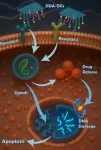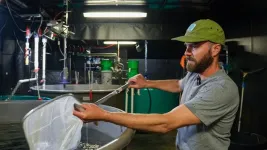(Press-News.org) All states should adopt updated screening protocols so more newborns with cystic fibrosis can be diagnosed in the first weeks of life, when interventions can have the greatest benefit, according to the Cystic Fibrosis Foundation guidelines published April 2 in the International Journal of Neonatal Screening.
Current newborn screening protocols vary across states. Some states use outdated protocols that often miss cases of the inherited disease, especially in newborns with Black, Hispanic and Asian, as well as American Indian and multiracial ancestry, said Dr. Meghan McGarry, a pediatric lung specialist and associate professor of pediatrics at the University of Washington School of Medicine.
McGarry and Karen Siklosi Raraig, assistant professor of genetic medicine, Johns Hopkins University, were the co-lead authors of the guidelines.
“Because the disease impairs the newborn’s ability to absorb nutrients, a delay in diagnosis of a week or so can lead to damaging weight loss and other complications,” McGarry said. “If the diagnosis is missed, you will often see serious growth problems and permanent lung damage as the child grows older.”
Cystic fibrosis is an inherited disorder that affects about 40,000 children and adults in the United States. It occurs when a child inherits two mutated copies of a certain gene, one from each parent. This gene normally provides instructions for the synthesis of a protein called the cystic fibrosis transmembrane conductance regulator (CFTR), which controls the movement of salt and water in and out of cells.
Mutations that prevent the synthesis of this protein, or that produce abnormal versions of the protein, can have a profound effect on the function of cells that produce mucous, sweat and other secretions. They can make mucous and secretions thick and gluey, and make sweat extra salty. The thickened secretions can block and damage secreting glands and allow infections to occur, particularly in the lungs.
People with cystic fibrosis can develop endocrine, gastrointestinal, pancreatic, liver and reproductive disorders, but lung disease is often the most common complication and the principal cause of death. With early diagnosis and new treatments, life expectancy of people with cystic fibrosis has improved greatly in recent years, but many still succumb in their 40s.
Currently, all U.S. newborns are screened for cystic fibrosis. This is done by collecting a few drops of blood from a heel prick. The blood is tested for a protein called immunoreactive trypsinogen (IRT), which tends to run high in newborns with cystic fibrosis. If the IRT level is elevated, another sample of blood is collected to screen the newborn’s DNA for mutations in the CFTR gene. If mutations are identified, additional tests will be done to confirm the diagnosis.
Although all states test for IRT, McGarry said, they differ on what levels are considered an abnormal finding. This disparity causes some cystic fibrosis cases to be missed. States also differ in the number of mutations they screen for. Although more than 1,000 mutations are now known to cause cystic fibrosis, some states test for only one mutation, and others for only 40. Limited DNA tests can miss many cases to be missed, particularly in newborns with rarer mutations that are found more in Asian, Hispanic, Black, American Indian and multiracial babies, the guideline authors note.
The Cystic Fibrosis Foundation’s new guidelines call for uniform screening protocols in all states. They also recommend that IRT screening labs should be run twice a week to preclude delays in diagnosis, and that IRT screens use metrics that account for factors like temperature and humidity, which can affect results. The guidelines also state that when IRT levels are elevated, laboratories should screen for all mutations known to cause cystic fibrosis.
The guideline writers also note that a positive test finding is not necessarily a formal diagnosis, nor does a negative test mean the child does not have cystic fibrosis.
“If a baby presents with signs and symptoms of cystic fibrosis, pediatricians should not rule out cystic fibrosis solely on the basis of their normal newborn screening,” McGarry said. “Families have faced difficulties getting further testing, despite the baby showing classic signs of cystic fibrosis, based on a normal initial screen.”
Currently, a formal diagnosis is made with a relatively simple test that measures the chloride content of a person’s sweat.
“Newborn screening should be updated and standardized so that it benefits all families equally,” McGarry said. “All babies deserve early diagnosis and early treatment so they can have the best outcomes.”
The guidelines appear in the DATE issue of the International Journal of Neonatal Screening. Marci Sontag, director of the Center for Public Health Innovation, and Dr. Susanna McColley, professor of pediatrics at the Northwestern University Feinberg School of Medicine in Chicago, were the senior authors of the guidelines.
END
New guidelines aim to improve cystic fibrosis screening
Many newborn screening protocols miss cases of the disease in Black, Hispanic, Asian, and Native American newborns
2025-04-03
ELSE PRESS RELEASES FROM THIS DATE:
Picky eaters by day, buffet by night: Butterfly, moth diets sync to plant aromas
2025-04-03
UNIVERSITY PARK, Pa. — The scent of blooming flowers and fresh plant life is not just a perk of springtime; it is a key driver in the survival and evolution of butterflies and moths. New research led by scientists at Penn State reveals how the daily cycles of plant aromas are linked to the dietary habits and evolution of the winged insects collectively known as Lepidoptera.
In a recent study published in the journal Proceedings of the Royal Society B, an international team of researchers tested a new hypothesis for why some Lepidoptera have very specific diets, feeding on only a few types ...
Pennington Biomedical’s Dr. Leanne Redman honored with the E. V. McCollum Award from the American Society for Nutrition
2025-04-03
The American Society for Nutrition, or ASN, and the ASN Foundation announced the distinguished recipients of the 2025 National Scientific Achievement Awards today. Recognizing outstanding contributions and pioneering advancements in the field of nutrition, these awards serve as a testament to excellence and innovation. Among the honorees is Pennington Biomedical Research Center’s Dr. Leanne Redman, who received the E. V. McCollum Award – given to a clinical investigator who is perceived as a major creative force, actively generating new concepts in nutrition and personally seeing to the execution of studies testing the validity of these concepts.
Dr. Redman is associate ...
CCNY physicists uncover electronic interactions mediated via spin waves
2025-04-03
Groundbreaking research by physicists at The City College of New York is being credited for a novel discovery regarding the interaction of electronic excitations via spin waves. The finding by the Laboratory for Nano and Micro Photonics (LaNMP) team headed by physicist Vinod Menon could open the door to future technologies and advanced applications such as optical modulators, all-optical logic gates, and quantum transducers. The work is reported in the journal Nature Materials.
The researchers showed the emergence of interaction between electronic excitations (excitons – electron hole pairs) mediated via spin waves in atomically thin (2D) magnets. They demonstrated ...
Researchers’ 3D-printing formula may transform future of foam
2025-04-03
From seat cushions to mattresses to insulation, foam is everywhere — even if we don’t always see it.
Now, researchers at The University of Texas at Dallas have fused chemistry with technology to create a 3D-printed foam that is more durable and more recyclable than the polymer foam found in many everyday products.
The research, which appears in the March 1 print edition of RSC Applied Polymers, a journal of the Royal Society of Chemistry, focused on creating a sturdy but lightweight foam that could be 3D-printed, a method that is still largely unexplored in commercial manufacturing, said the study’s co-lead author, UT Dallas doctoral student Rebecca Johnson ...
Nurture more important than nature for robotic hand
2025-04-03
How does a robotic arm or a prosthetic hand learn a complex task like grasping and rotating a ball? The challenge for the human, prosthetic or robotic hand has always been to correctly learn to control the fingers to exert forces on an object. The sensitive skin and nerve endings that cover our hands have been attributed with helping us learn and adapt our manipulation, so roboticists have insisted on incorporating sensors on robotic hands. But–given that you can still learn to handle objects with gloves on– there must be something else at play.
This mystery is what inspired researchers in the ValeroLab in the Viterbi School of Engineering ...
Drug-delivering aptamers target leukemia stem cells for one-two knockout punch
2025-04-03
CHAMPAIGN, Ill. — Drug-carrying DNA aptamers can deliver a one-two punch to leukemia by precisely targeting the elusive cancer stem cells that seed cancer relapses, researchers at the University of Illinois Urbana-Champaign report.
The aptamers — short single-strand snippets of DNA that can target molecules like larger antibodies do — not only deliver cancer-fighting drugs, but also are themselves toxic to the cancer stem cells, the researchers said.
Led by Xing Wang, a U. of I. professor of bioengineering and of chemistry, the researchers documented their findings in the journal Advanced Functional Materials.
“This ...
New study finds that over 95% of sponsored influencer posts on Twitter were not disclosed
2025-04-03
New INFORMS journal Marketing Science Article Key Takeaways:
Over 95% of sponsored influencer posts on Twitter were not disclosed.
Influencer sponsorship arrangements with younger brands are less likely to be disclosed.
A large number of consumers can’t detect the sponsorship arrangement without disclosure.
The consumer-protection regulatory environment around undisclosed sponsorships has lagged behind.
BALTIMORE, MD, April 3, 2025 – New research in the peer-reviewed journal Marketing Science has found that 95% of influencer posts on Twitter (now X), which are sponsored, are not disclosed.
The ...
New sea grant report helps great lakes fish farmers navigate aquaculture regulations
2025-04-03
DULUTH, Minn.–Fish farmers across the Great Lakes states can face a confusing web of permits, policies and regulations that can hinder the growth of their operations. A new Sea Grant publication, Aquaculture Regulations in the Great Lakes, offers much-needed clarity.
The report breaks down complex legal frameworks and provides practical insights to help aquaculture producers understand and navigate state and regional requirements with greater confidence. It was developed by the National Sea Grant Law Center (NSGLC) ...
Strain “trick” improves perovskite solar cells’ efficiency
2025-04-03
Solar energy is one of the most promising solutions for reducing our dependence on fossil fuels. But making solar panels more efficient is a constant challenge. Perovskite solar cells (PSCs) have been a game-changer, offering rapid improvements in efficiency and potential for low-cost manufacturing. However, they still suffer from energy losses and operational stability issues.
The challenge with wide-bandgap perovskites
Perovskite solar cells, particularly those used in tandem configurations, rely on wide-bandgap (WBG) materials—semiconductors that absorb higher-energy ("bluer") ...
How GPS helps older drivers stay on the roads
2025-04-03
How GPS helps older drivers stay on the roads
Peer reviewed – observational study - humans
Sat Nav systems help keep older drivers on the roads for longer, according to new research from the University of East Anglia.
A new study published today reveals that over 65s with a poorer sense of direction rely more on help from GPS navigation systems such as Sat Nav or smartphone maps.
Those using GPS tended to drive more frequently - suggesting that the technology helps older people maintain driving independence.
Senior author Prof Michael Hornberger, from UEA’s Norwich Medical School, said: “Driving is usually the preferred mode of transport among ...
LAST 30 PRESS RELEASES:
Manta rays create mobile ecosystems, study finds
Study: Mixed results in using lipoic acid to treat progressive multiple sclerosis
Norbert Holtkamp appointed director of Fermi National Accelerator Laboratory
New agentic AI platform accelerates advanced optics design
Biologists discover neurons use physical signals — not electricity — to stabilize communication
Researchers discover that a hormone can access the brain by hitchhiking
University of Oklahoma researcher awarded funding to pursue AI-powered material design
Exploring how the visual system recovers following injury
Support for parents with infants at pediatric check-ups leads to better reading and math skills in elementary school
Kids’ behavioral health is a growing share of family health costs
Day & night: Cancer disrupts the brain’s natural rhythm
COVID-19 vaccination significantly reduces risk to pregnant women and baby
The role of vaccination in maternal and perinatal outcomes associated with COVID-19 in pregnancy
Mayo Clinic smartwatch system helps parents shorten and defuse children's severe tantrums early
Behavioral health spending spikes to 40% of all children’s health expenditures, nearly doubling in a decade
Digital cognitive behavioral treatment for generalized anxiety disorder
Expenditures for pediatric behavioral health care over time and estimated family financial burden
Air conditioning in nursing homes and mortality during extreme heat
The Alps to lose a record number of glaciers in the next decade
What makes a good proton conductor?
New science reporting guide published for journalists in Bulgaria
New international study reveals major survival gaps among children with cancer
New science reporting guide published for journalists in Turkey
Scientists develop a smarter mRNA therapy that knows which cells to target
Neuroanatomy-informed brain–machine hybrid intelligence for robust acoustic target detection
Eight SwRI hydrogen projects funded by ENERGYWERX
The Lundquist Institute and its start-up company Vitalex Biosciences Announces Strategic Advancement of Second-Generation fungal Vaccine VXV-01 through Phase 1 Trials under $40 Million Competitive Con
Fine particles in pollution are associated with early signs of autoimmune disease
Review article | Towards a Global Ground-Based Earth Observatory (GGBEO): Leveraging existing systems and networks
Penn and UMich create world’s smallest programmable, autonomous robots
[Press-News.org] New guidelines aim to improve cystic fibrosis screeningMany newborn screening protocols miss cases of the disease in Black, Hispanic, Asian, and Native American newborns





